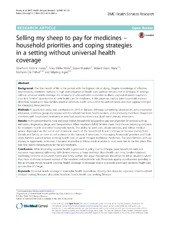| dc.description.abstract | Background: The first month of life is the period with the highest risk of dying. Despite knowledge of effective interventions, newborn mortality is high and utilization of health care services remains low in Ethiopia. In settings without universal health coverage, the economy of a household is vulnerable to illness, and out-of-pocket payments may limit families’ opportunities to seek health care for newborns. In this paper we explore intra-household resource allocation, focusing on how families prioritize newborn health versus other household needs and their coping strategies for managing these priorities. Methods: A qualitative study was conducted in 2015 in Butajira, Ethiopia, comprising observation, semi-structured interviews, and focus group discussions with household members, health workers, and community members. Household members with hospitalized newborns or who had experienced neonatal death were primary informants. Results: In this predominantly rural and poor district, households struggled to pay out-of-pocket for services such as admission, diagnostics, drugs, and transportation. When newborns fell ill, families made hard choices balancing concerns for newborn health and other household needs. The ability to seek care, obtain services, and follow medical advice depended on the social and economic assets of the household. It was common to borrow money from friends and family, or even to sell a sheep or the harvest, if necessary. In managing household priorities and high costs, families waited before seeking health care, or used cheaper traditional medicines. For poor families with no money or opportunity to borrow, it became impossible to follow medical advice or even seek care in the first place. This had fatal health consequences for the sick newborns. Conclusions: While improving neonatal health is prioritized at policy level in Ethiopia, poor households with sick neonates may prioritize differently. With limited money at hand and high direct health care costs, families balanced conflicting concerns to newborn health and family welfare. We argue that families should not be left in situations where they have to choose between survival of the newborn and economic ruin. Protection against out-of-pocket spending is key as Ethiopia moves towards universal health coverage. A necessary step is to provide prioritized newborn health care services free of charge. | en_US |

